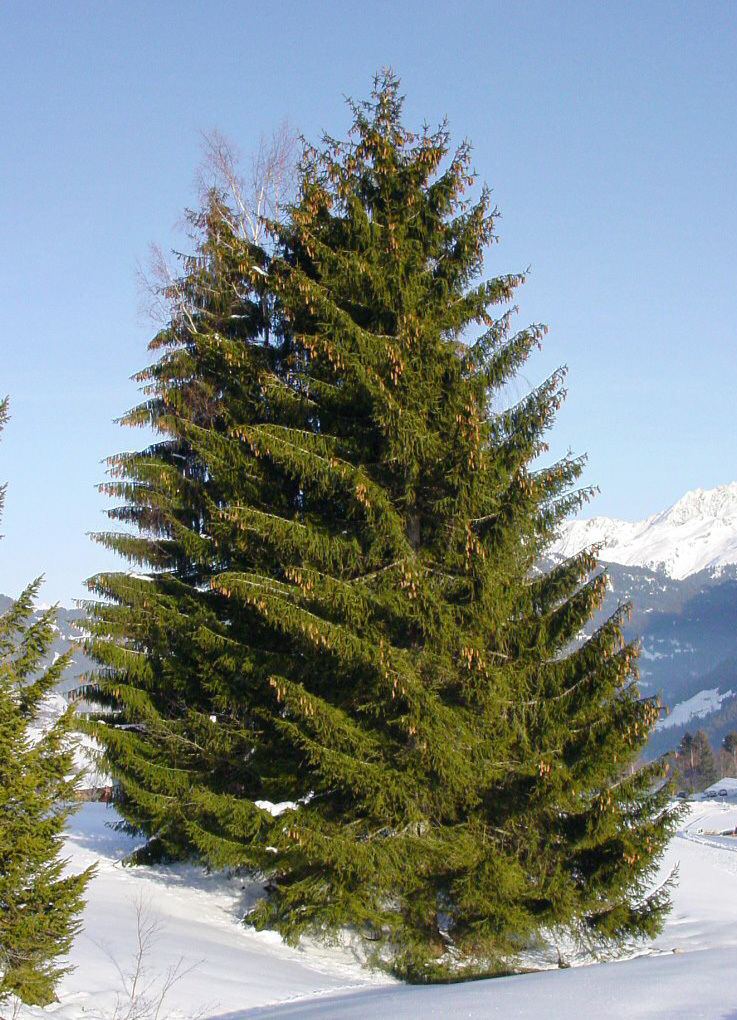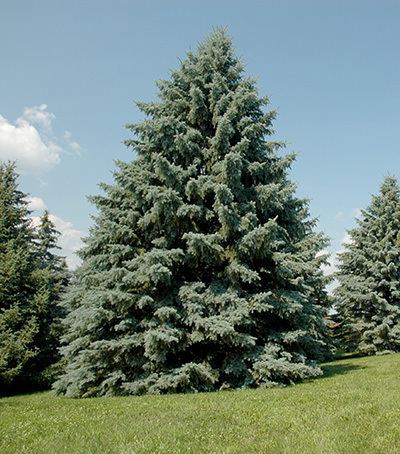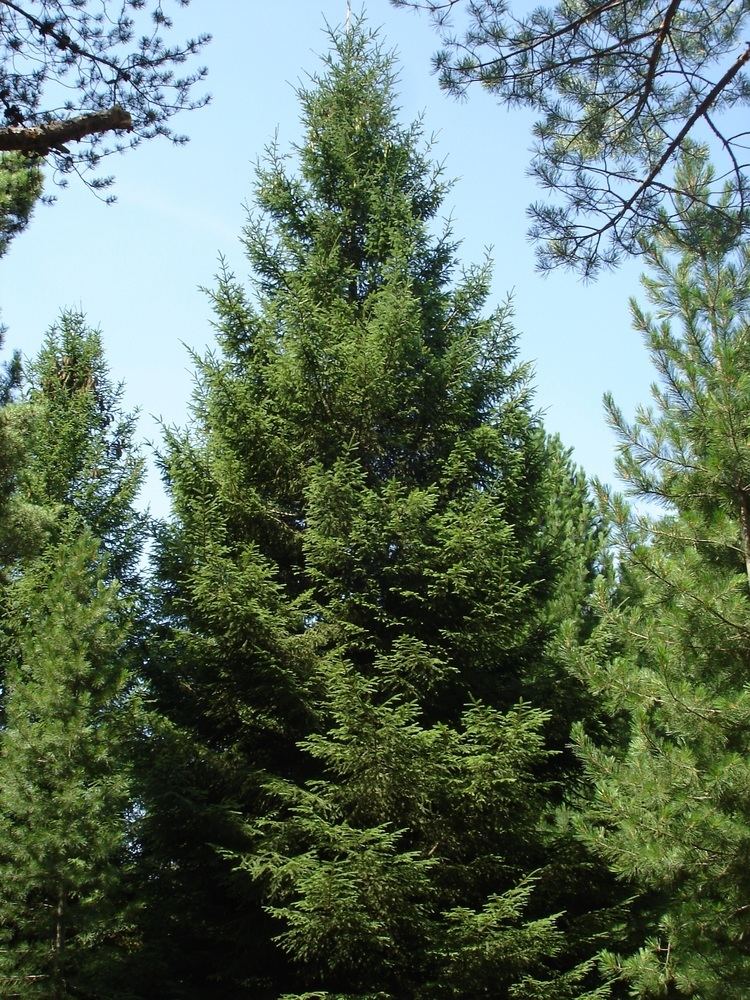Scientific name Picea Rank Genus | Division Pinophyta Subfamily PiceoideaeFrankis | |
 | ||
Lower classifications Norway spruce, Blue spruce, White spruce, Picea omorika, Picea sitchensis | ||
Plant a blue spruce tree
A spruce is a tree of the genus Picea /paɪˈsiːə/, a genus of about 35 species of coniferous evergreen trees in the family Pinaceae, found in the northern temperate and boreal (taiga) regions of the earth. Spruces are large trees, from about 20–60 m (about 60–200 ft) tall when mature, and can be distinguished by their whorled branches and conical form. The needles, or leaves, of spruce trees are attached singly to the branches in a spiral fashion, each needle on a small, peg-like structure. The needles are shed when 4–10 years old, leaving the branches rough with the retained pegs (an easy means of distinguishing them from other similar genera, where the branches are fairly smooth).
Contents
- Plant a blue spruce tree
- How to eat a spruce tree picking and using spruce tips
- Etymology
- Classification
- Species
- Morphology
- Growth
- Timber
- Pulpwood
- Food and medicine
- Tonewood
- Other uses
- Sirococcus conigenus blight Deuteromycotina Coelomtcetes
- Rhizosphaera kalkhoffi needle cast
- Valsa kunzei branch and stem canker
- Predators
- References

Spruces are used as food plants by the larvae of some Lepidoptera (moth and butterfly) species. They are also used by the larvae of gall adelgids (Adelges species).
In the mountains of western Sweden, scientists have found a Norway spruce tree, nicknamed Old Tjikko, which by reproducing through layering, has reached an age of 9,550 years and is claimed to be the world's oldest known living tree.

How to eat a spruce tree picking and using spruce tips
Etymology
The word "spruce" entered the English language from the Polish Prusy, Prussia (a historical region, today part of Poland and Kaliningrad Oblast). It became spruce because in Polish, z Prus ("from Prussia") sounded like "spruce" to English speakers and was a generic term for commodities brought to England by Hanseatic merchants and because the tree was believed to have come from Polish Ducal Prussia.
Classification

DNA analyses have shown that traditional classifications based on the morphology of needle and cone are artificial. A recent study found that P. breweriana had a basal position, followed by P. sitchensis, and the other species were further divided into three clades, suggesting that Picea originated in North America. Spruce has been found in the fossil record from the early Cretaceous, 136 million years ago.
Species
Thirty-five named species of spruce exist in the world. The Plant List has 59 accepted spruce names.
Basal species:

Morphology

Determining that a tree is a member of a spruce species is not difficult; evergreen needles that are more or less quadangled, and especially the pulvinus, give it away. Beyond that, determination can become more difficult. Intensive sampling in the Smithers/Hazelton/Houston area of British Columbia showed Douglas (1975), according to Coates et al. (1994), that cone scale morphology was the feature most useful in differentiating species of spruce; the length, width, length: width ratio, the length of free scale (the distance from the imprint of the seed wing to the tip of the scale), and the percentage free scale (length of free scale as a percentage of the total length of the scale) were most useful in this regard. Daubenmire (1974), after range-wide sampling, had already recognized the importance of the 2 latter characters. Taylor (1959) had noted that the most obvious morphological difference between typical Picea glauca and typical P. engelmannii was the cone scale, and Horton (1956,1959) found that the most useful diagnostic features of the 2 spruces are in the cone; differences occur in the flower, shoot and needle, "but those in the cone are most easily assessed" (Horton 1959). Coupé et al. (1982) recommended that cone scale characters be based on samples taken from the midsection of each of 10 cones from each of 5 trees in the population of interest.

Without cones, morphological differentiation among spruce species and their hybrids is more difficult. Species classification for seeds collected from spruce stands in which introgressive hybridization between white and Sitka spruces (P. sitchensis) may have occurred is important for determining appropriate cultural regimens in the nursery. If, for instance, white spruce grown at container nurseries in southwestern British Columbia are not given an extended photoperiod, leader growth ceases early in the first growing season, and seedlings do not reach the minimum height specifications. But, if an extended photoperiod is provided for Sitka spruce, seedlings become unacceptably tall by the end of the first growing season . Species classification of seedlots collected in areas where hybridization of white and Sitka spruces has been reported has depended on (i) easily measured cone scale characters of seed trees, especially free scale length, (ii) visual judgements of morphological characters, e.g., growth rhythm, shoot and root weight, and needle serration, or (iii) some combination of (i) and (ii) (Yeh and Arnott 1986). Useful to a degree, these classification procedures have important limitations; genetic composition of the seeds produced by a stand is determined by both the seed trees and the pollen parents, and species classification of hybrid seedlots and estimates of their level of introgression on the basis of seed-tree characteristics can be unreliable when hybrid seedlots vary in their introgressiveness in consequence of spatial and temporal variations in contributions from the pollen parent (Yeh and Arnott 1986). Secondly, morphological characters are markedly influenced by ontogenetic and environmental influences, so that to discern spruce hybrid seedlot composition with accuracy, hybrid seedlots must differ substantially in morphology from both parent species. Yeh and Arnott (1986) pointed out the difficulties of estimating accurately the degree of introgression between white and Sitka spruces; introgression may have occurred at low levels, and/or hybrid seed lots may vary in their degree of introgression in consequence of repeated backcrossing with parental species.
Growth

Spruce seedlings are most susceptible immediately following germination, and remain highly susceptible through to the following spring. More than half of spruce seedling mortality probably occurs during the first growing season and is also very high during the first winter, when seedlings are subjected to freezing damage, frost heaving and erosion, as well as smothering by litter and snow-pressed vegetation. Seedlings that germinate late in the growing season are particularly vulnerable because they are tiny and have not had time to harden off fully.
Mortality rates generally decrease sharply thereafter, but losses often remain high for some years. "Establishment" is a subjective concept based on the idea that once a seedling has successfully reached a certain size, not much is likely to prevent its further development. Criteria vary, of course, but Noble and Ronco (1978), for instance, considered that seedlings 4 to 5 years old, or 8 cm to 10 cm tall, warranted the designation "established", since only unusual factors such as snow mold, fire, trampling, or predation would then impair regeneration success. Eis (1967) suggested that in dry habitats on either mineral soil or litter seedbeds a 3-year-old seedling may be considered established; in moist habitats, seedlings may need 4 or 5 years to become established on mineral soil, possibly longer on litter seedbeds.
Growth remains very slow for several to many years. Three years after shelterwood felling in subalpine Alberta, dominant regeneration averaged 5.5 cm in height in scarified blocks, and 7.3 cm in non-scarified blocks (Day 1970), possibly reflecting diminished fertility with the removal of the A horizon.
Timber
Spruce is useful as a building wood, commonly referred to by several different names including North American timber, SPF (spruce, pine, fir) and whitewood (the collective name for spruce wood). Spruce wood is used for many purposes, ranging from general construction work and crates to highly specialised uses in wooden aircraft. The Wright brothers' first aircraft, the Flyer, was built of spruce.
Because this species has no insect or decay resistance qualities after logging, it is generally recommended for construction purposes as indoor use only (ex. indoor drywall framing). Spruce wood, when left outside cannot be expected to last more than 12–18 months depending on the type of climate it is exposed to.
Pulpwood
Spruce is one of the most important woods for paper uses, as it has long wood fibres which bind together to make strong paper. The fibres are thin walled and collapse to thin bands upon drying. Spruces are commonly used in mechanical pulping as they are easily bleached. Together with northern pines, northern spruces are commonly used to make NBSK. Spruces are cultivated over vast areas as pulpwood.
Food and medicine
The fresh shoots of many spruces are a natural source of vitamin C. Captain Cook made alcoholic sugar-based spruce beer during his sea voyages in order to prevent scurvy in his crew. The leaves and branches, or the essential oils, can be used to brew spruce beer.
The tips from the needles can be used to make spruce tip syrup . In survival situations spruce needles can be directly ingested or boiled into a tea. This replaces large amounts of vitamin C. Also, water is stored in a spruce's needles, providing an alternative means of hydration . Spruce can be used as a preventive measure for scurvy in an environment where meat is the only prominent food source .
Tonewood
Spruce is the standard material used in soundboards for many musical instruments, including guitars, mandolins, cellos, violins, and the soundboard at the heart of a piano and the harp. Wood used for this purpose is referred to as tonewood.
Spruce, along with cedar, is often used for the soundboard/top of an acoustic guitar. The main types of spruce used for this purpose are Sitka, Engelmann, Adirondack and European spruces.
Other uses
The resin was used in the manufacture of pitch in the past (before the use of petrochemicals); the scientific name Picea is generally thought to be derived from Latin pix, pitch (though other etymologies have been suggested).
Native Americans in North America use the thin, pliable roots of some species for weaving baskets and for sewing together pieces of birch bark for canoes. See also Kiidk'yaas for an unusual golden Sitka Spruce sacred to the Haida people.
Spruces are popular ornamental trees in horticulture, admired for their evergreen, symmetrical narrow-conic growth habit. For the same reason, some (particularly Picea abies and P. omorika) are also extensively used as Christmas trees.
Spruce branches are also used at Aintree racecourse, Liverpool, to build several of the fences on the Grand National course. It is also used to make sculptures.
Sirococcus conigenus blight (Deuteromycotina, Coelomtcetes)
Sirococcus conigenus causes shoot blight and seedling mortality of conifers in North America, Europe, and North Africa. Under its former name, Ascochyta piniperda, twig blight damage to seedlings of white and red spruces in a nursery near Asheville, North Carolina, were reported by Graves (1914). Hosts include white, black, Engelmann, Norway, and red spruces, although they are not the plants most commonly damaged. Sirococcus blight of spruces in nurseries show up randomly in seedlings to which the fungus was transmitted in infested seed. First-year seedlings are often killed, and larger plants may become too deformed for planting. Outbreaks involving < 30% of spruce seedlings in seedbeds have been traced to seed lots in which only 0.1% to 3% of seeds were infested. Seed infestation has in turn been traced to the colonization of spruce cones by S. conigenus in forests of the western interior. Infection develops readily if conidia are deposited on succulent plant parts that remain wet for at least 24 hours at 10 °C to 25 °C. Longer periods of wetness favour increasingly severe disease. Twig tips killed during growth the previous year shows a characteristic crook.
Rhizosphaera kalkhoffi needle cast
Rhizosphaera infects white spruce, blue spruce (Picea pungens), and Norway spruces throughout Ontario, causing severe defoliation and sometimes killing small, stressed trees. White spruce is intermediately susceptible. Dead needles show rows of black fruiting bodies. Infection usually begins on lower branches. On white spruce, infected needles are usually retained on the tree into the following summer. The fungicide Chlorthalonil is registered for controlling this needle cast (Davis 1997).
Valsa kunzei branch and stem canker
A branch and stem canker associated with the fungus Valsa kunzei Fr. var. picea was reported on white and Norway spruces in Ontario (Jorgensen and Cafley 1961) and Quebec (Ouellette and Bard 1962). In Ontario, only trees of low vigour were affected, but in Quebec vigorous trees were also infected.
Predators
Small mammals consume conifer seeds, and also eat seedlings. Cage feeding of deer mice (Peromyscus maniculatus) and red-backed vole (Myodes gapperi) showed a daily maximum seed consumption of 2000 white spruce seeds and of 1000 seeds of lodgepole pine, with the 2 species of mice consuming equal amounts of seed, but showing a preference for the pine over the spruce (Wagg 1963). The short-tailed meadow vole (Microtus pennsylvanicus Ord) voraciously ate all available white spruce and lodgepole pine seedlings, pulling them out of the ground and holding them between their front feet until the whole seedling had been consumed. Wagg (1963) attributed damage observed to the bark and cambium at ground level of small white spruce seedlings over several seasons to meadow voles.
Once shed, seeds contribute to the diet of small mammals, e.g., deer mice, red-backed voles, mountain voles (Microtus montanus), and chipmunks (Eutamias minimus). The magnitude of the loss is difficult to determine, and studies with and without seed protection have yielded conflicting results. In western Montana, for example, spruce seedling success was little better on protected than on unprotected seed spots (Schopmeyer and Helmers 1947), but in British Columbia spruce regeneration depended on protection from rodents (Smith 1955).
An important albeit indirect biotic constraint on spruce establishment is the depredation of seed by squirrels. As much as 90% of a cone crop has been harvested by red squirrels (Zasada et al. 1978). Deer mice, voles, chipmunks, and shrews can consume large quantities of seed; 1 mouse can eat 2000 seeds per night (Radvanyi 1970b). Repeated applications of half a million seeds/ha failed to produce the 750 trees/ha sought by Northwest Pulp and Power, Ltd., near Hinton, Alberta (Radvanyi 1972), but no doubt left a lot of well-fed small mammals. Foraging by squirrels for winter buds (Rowe 1952) has not been reported in relation to young plantations, but Wagg (1963) noted that at Hinton AB, red squirrels were observed cutting the lateral and terminal twigs and feeding on the vegetative and flower buds of white spruce.
Red squirrels in Alaska have harvested as much as 90% of a cone crop (Zasada et al. 1978); their modus operandi is to cut off great numbers of cones with great expedition early in the fall, and then "spend the rest of the fall shelling out the seeds". In Manitoba, Rowe (1952) ascribed widespread severing of branch tips 5 cm to 10 cm long on white spruce ranging "from sapling to veteran size" to squirrels foraging for winter buds, cone failure having excluded the more usual food source. The damage has not been reported in relation to small trees, outplants or otherwise.
Porcupines (Erethizon dorsatum L.) may damage spruce (Nienstaedt 1957), but prefer red pine (McLeod 1956). Bark-stripping of white spruce by black bear (Euarctos americanus perniger) is locally important in Alaska (Lutz 1951), but the bark of white spruce is not attacked by field mice (Microtus pennsylvanicus Ord) (Littlefield et al. 1946), even in years of heavy infestation.
